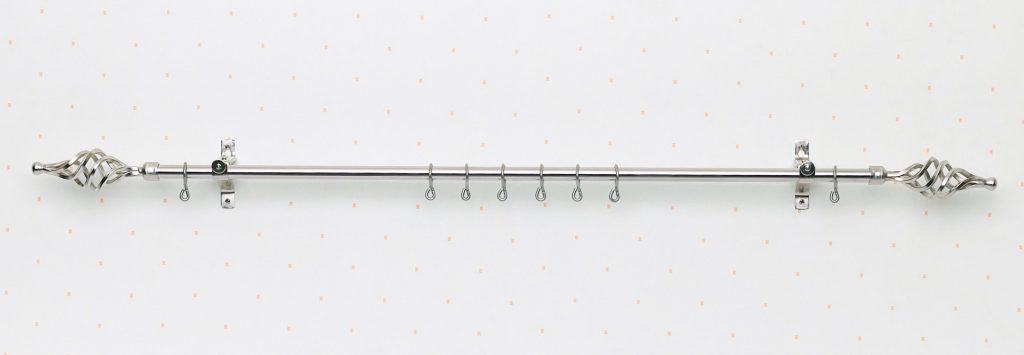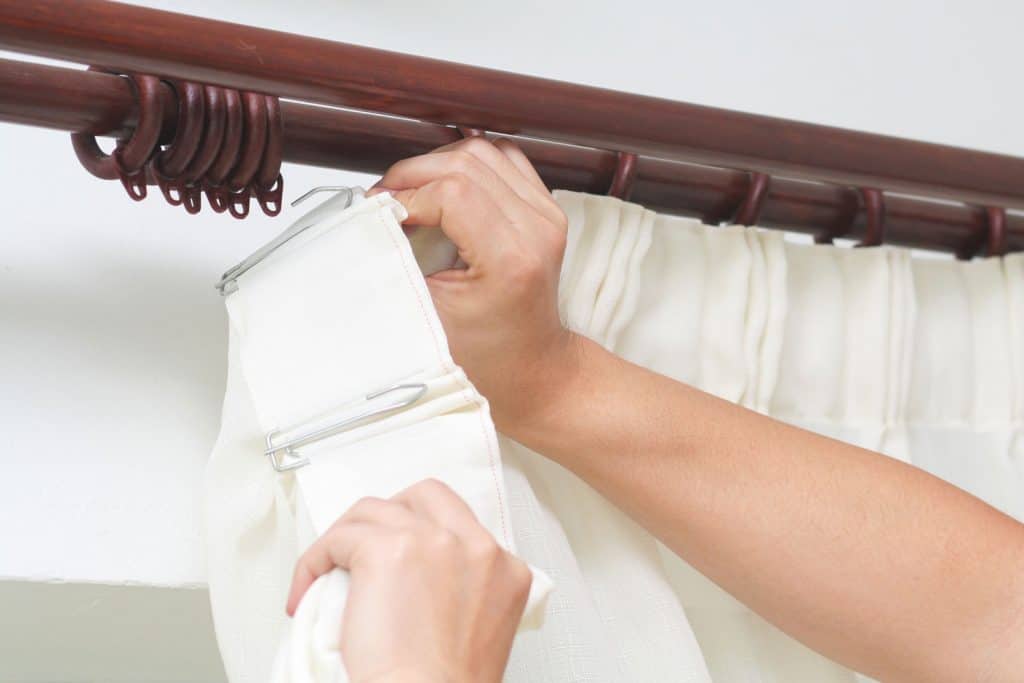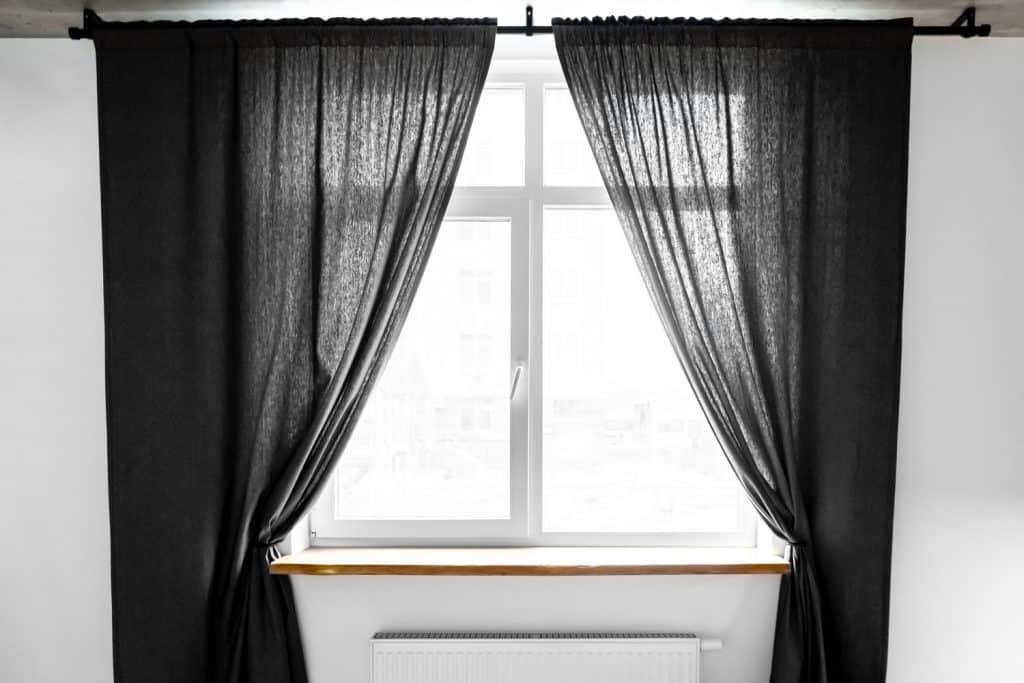- Insert one hook into the curtain ring.
- Measure the distance on the rod between the bottom of the hanging hook and the top of the curtain hardware.
- Attach curtain hooks to each panel, corresponding to the measurement you just took. Place one in each pleat and at either end.
- Fold the space between each pleat together.
- Hang each hook from the rings or gliders.
In this guide, we'll cover each step in greater detail. We'll also cover other common questions when it comes to pinch pleat curtains, so be sure to keep reading.
![Brown and white pinch pleated curtains inside a modern living room, How To Hang Pinch Pleat Curtains [5 Steps]](https://homedecorbliss.com/wp-content/uploads/2021/02/How-To-Hang-Pinch-Pleat-Curtains-5-Steps-682x1024.jpg)
Hanging Pinch Pleat Curtains
Pinch pleat curtains are a decorative style of drapery. The material used is two or three times wider than the length of the curtain rod. Pleats are formed by gathering the excess material into a tight gathering. This extra material is then bunched and stitched together. As a result, it creates a more ornate, luxurious looking curtain with rich, elegant folds.
The curtains are hung by curtain hooks. Some pinch pleat curtains are sold with the hooks. Or, if you need to buy your own hooks, you'll want something like this:
We may include affiliate links and curated AI content to highlight top design styles.
Click here to see these curtain hooks on Amazon.
In all, you'll need a hook for each pleat and two extra for the ends. You can use a traverse rod with gliders or a curtain rod with rings. In either case, you'll need a glider or ring for each hook. For example, if your curtain has ten pleats, you will need 12 hooks and 12 curtain rings (or gliders).
Measuring The Curtains
First, hang one of the hooks into the curtain ring or glider. Measure the space from the bottom of the hook to the top of the curtain rod and hardware. You want to determine just how low the hooks must be inserted on the curtain to cover the curtain rod from view adequately.

At this point, you can rest the curtain flat on a table, counter, or another similar surface. Be sure to lay the curtain flat, so it doesn't wrinkle - pinch pleat curtains are particularly prone to bunching and wrinkling if not handled gently.
Attach Curtain Hooks
Using the measurement you found above, mark the correct spot on the curtain. Use a pin at each pleat to indicate the proper depth for the curtain hook. Insert the hooks so that there is one on each end and one at each pleat. Be careful that the hooks do not pierce through to the front of the curtain.
After hanging a few hooks, test the panel. Hang it from the curtain to make sure the pins are inserted at the right level. If they are too high or low, and will not hang from the rod correctly, then adjust. Once you have the correct "hang," finish adding the rest of the hooks. The hooks on either end should hang in the middle of the hem allowance.
As you insert each hook, be sure that they are all about the same size. The opening on each hook should be roughly the same. If one hook seems much looser than the others, then squeeze or tighten it together. This will ensure that the curtain hangs straight, without drooping.
Fold The Pleats
To keep each pleat looking smooth and polished, fold the space between the pleats before hanging the curtain. If your curtains will hang from a curtain rod and ring system, you can fold the space between pleats inward or outward. However, if you are using a track system with gliders, you must fold the pleats outward toward the front of the curtain.
Pinch and bunch the pleats together, folding the material between pleats as you go. At the end of the panel, fold the hem allowance in half.
Some people choose to tie the curtains together at this point. By using a string or ribbon, you can band the curtain together. This keeps the folds in place. As a result, this may be easier to manage when you hang the curtain.
Hang The Curtain
Slide the loop of each hook through the eyelet of each ring or glider. Work carefully so that you match every hook to the right spot. Pay attention, and don't skip any - if you mess up, you will have to go back and redo every hook that is out of place. Be sure to support the weight of the curtain until all the hooks are in place.

Adjust and fluff the curtains, adding your second curtain panel if needed. Fix each pleat and the folds of material until the curtain hangs as desired. Ta-da! You did it!
Need more help? Try this video:
PS: If you're still confused by just how a traverse rod and gliders work, read here for more information.
How Do You Hang Pinch Pleat Curtains With Clips?
If the idea of a bunch of little curtain hooks sounds like a nightmare, that's okay. Ring clips have become increasingly popular as the simple, no-fuss way to hang curtains. And they also work on pinch pleat curtains.
Just attach a clip to the top of each pleat and one clip at either end. Use a clip in place of a hook. The rest of the process is, for the most part, unchanged.
How Do You Hide Curtain Ring Clips?
This will vary a bit on the curtain. However, you should be able to find a space in each gathered pleat somewhere near the header that you can place a clip. Much like the hook system, measure and place the clip appropriately. Go far enough down that the curtain header will cover the clip and other curtain hardware.
Depending on how the pleat is folded and sewn together, this will be easier with some curtains than others. If you have a hard time, you can always go with the more traditional curtain hooks.

How Much Space Should Be Between Floor and Curtains?
As a general rule, curtains are meant to hang to the floor. There are several different styles of curtain length. For example, pooling curtains have several inches of excess material that pools onto the floor. These are ideal for a room where you want luxurious or romantic decor. However, they can be a nuisance when it comes to ordinary tasks like vacuuming.
On the other hand, floating curtains stop about half an inch above the floor. These are great for high traffic areas where you don't want curtains - literally - underfoot. To learn more about different styles and rules for curtain length, read here.
How Much Space Do You Need Between Pinch Pleats?
Each pinch pleat is about four to six inches apart. For a 54" curtain, 4 or 5 pleats in all are relatively standard. Of course, this can vary depending on how full you like the curtains to look.
The actual pleats are about six to eight inches of material, apiece. Again, personal preference will depend on how much (or how little) fabric is in each pleat. For example, in a 54" panel, you may want five pleats that are four inches apart. This accounts for 20 inches of fabric, and each pleat contains 6 inches of material - this makes up another 30 inches. You have four inches left for a two-inch seam on either end of the curtain.
On the other hand, you may want fewer pleats but be able to use more material. For instance, four pleats that are four inches apart uses only 16 inches of fabric. You can make each pleat from eight inches of material, which will require a further 32 inches. In all, this is 48 inches of fabric, leaving you six inches. That means that there is a three-inch seam available on either side.
Either of these calculations will create nice drapery, but your personal taste may make one option more desirable than the other. Just remember that you must have some material for the seams on the end of the curtain. This material should not be wider than the distance between pleats, but it can be equal.
What Is The Difference Between Pinch Pleat And Pencil Pleat?
Pencil pleat curtains are the more "ordinary" standard for curtains. The material at the top that hangs off the rod is barely gathered. You can pull these curtains as flat as you like, letting them hang much like a smooth sheet.

Pinch pleat, on the other hand, bunches material together for a fuller, more decorative look. Fabric is folded and pulled, sewn together for permanent pleats or folds across the curtain. This type of curtain will never hang smoothly - it is meant to have a ruffled appearance. Each curtain typically has about three times the material of a pencil pleat curtain.
In Closing
Pinch pleat curtains look fancy, but they're actually pretty simple to hang. You can use curtain hooks at each pleat or clip rings. Hooks will let you hang your curtains from a traverse rod with gliders or a more standard curtain pole. Either system will give you gorgeous, full drapes that draw eyes.




I have pinch pleat drapes but the bottom of the pleat is sewn shut so how do I use the slide in hooks? They came with a traverse rod to hook pins in
Hi,
I have a Pencil Pleat Curtains, Tulle, and Valance, and would like to inquire how many tracks or poles do I need to hang them together?
Thank you